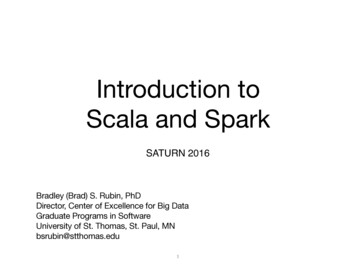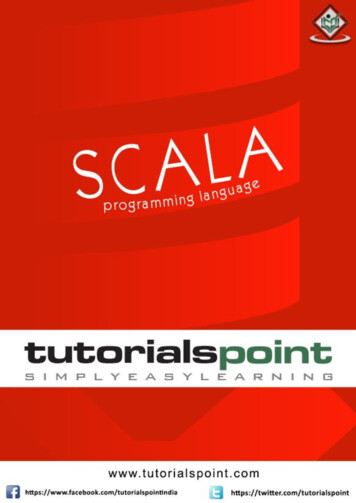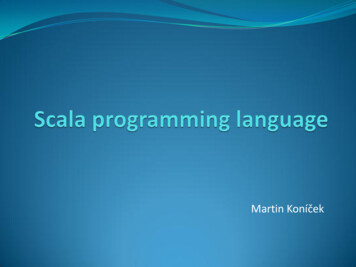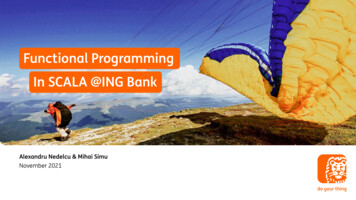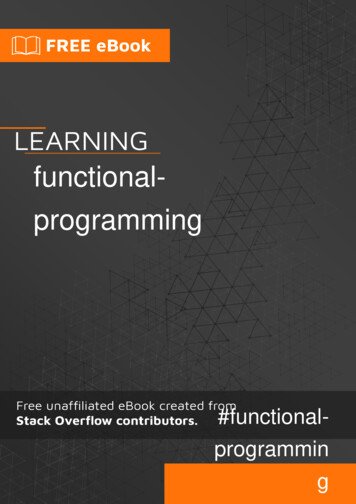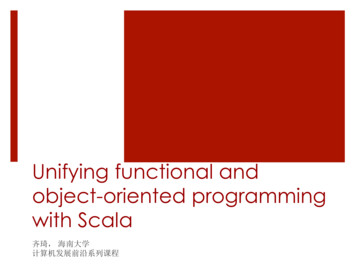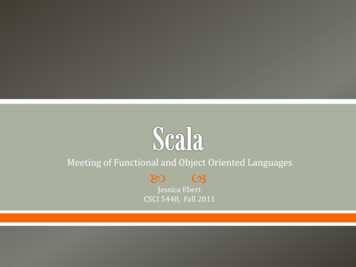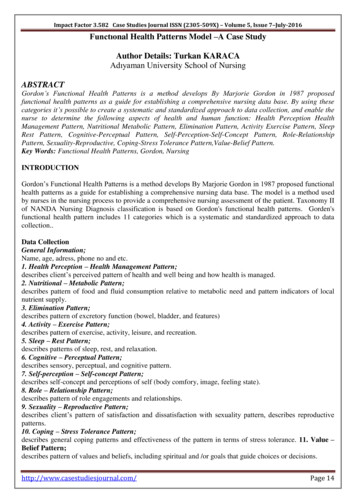
Transcription
Extracted from:Functional Programming Patternsin Scala and ClojureWrite Lean Programs for the JVMThis PDF file contains pages extracted from Functional Programming Patterns inScala and Clojure, published by the Pragmatic Bookshelf. For more informationor to purchase a paperback or PDF copy, please visit http://www.pragprog.com.Note: This extract contains some colored text (particularly in code listing). Thisis available only in online versions of the books. The printed versions are blackand white. Pagination might vary between the online and printed versions; thecontent is otherwise identical.Copyright 2013 The Pragmatic Programmers, LLC.All rights reserved.No part of this publication may be reproduced, stored in a retrieval system, or transmitted,in any form, or by any means, electronic, mechanical, photocopying, recording, or otherwise,without the prior consent of the publisher.The Pragmatic BookshelfDallas, Texas Raleigh, North Carolina
Functional Programming Patternsin Scala and ClojureWrite Lean Programs for the JVMMichael Bevilacqua-LinnThe Pragmatic BookshelfDallas, Texas Raleigh, North Carolina
Pattern 3Replacing CommandIntentTo turn a method invocation into an object and execute it in a central locationso that we can keep track of invocations so they can be undone, logged, andso forthOverviewCommand encapsulates an action along with the information needed to perform it. Though it seems simple, the pattern has quite a few moving parts.In addition to the Command interface and its implementations, there’s a client,which is responsible for creating the Command; an invoker, which is responsiblefor running it; and a receiver, on which the Command performs its action.The invoker is worth talking about a little because it’s often misunderstood.It helps to decouple the invocation of a method from the client asking for itto be invoked and gives us a central location in which all method invocationstake place. This, combined with the fact that the invocation is representedby an object, lets us do handy things like log the method invocation so it canbe undone or perhaps serialized to disk.Figure 3, Command Outline, on page 6 sketches out how Command fitstogether.A simple example is a logging Command. Here, the client is any class that needsto do logging and the receiver is a Logger instance. The invoker is the classthat the client calls instead of calling the Logger directly.Also Known AsActionFunctional ReplacementCommand has a few moving parts, as does our functional replacement. TheCommand class itself is a Functional Interface that generally carries state,so we’ll replace it with the closures we introduced in Pattern 2, ReplacingState-Carrying Functional Interface, on page ?. Click HERE to purchase this book now. discuss
6Figure 3—Command Outline. The outline of the Command patternNext we’ll replace the invoker with a simple function responsible for executingcommands, which I’ll call the execution function. Just like the invoker, the executionfunction gives us a central place to control execution of our commands, so wecan store or otherwise manipulate them as needed.Finally, we’ll create a Function Builder that’s responsible for creating ourcommands so we can create them easily and consistently.Sample Code: Cash RegisterLet’s look at how we’d implement a simple cash register with Command. Ourcash register is very basic: it only handles whole dollars, and it contains atotal amount of cash. Cash can only be added to the register.We’ll keep a log of transactions so that we can replay them. We’ll take a lookat how we’d do this with the traditional Command pattern first before movingon to the functional replacements in Scala and Clojure.Classic JavaA Java implementation starts with defining a standard Command interface.This is an example of Pattern 1, Replacing Functional Interface, on page ?.We implement that interface with a Purchase class.The receiver for our pattern is a CashRegister class. A Purchase will contain areference to the CashRegister it should be executed against. To round out thepattern, we’ll need an invoker, PurchaseInvoker, to actually execute our purchases. Click HERE to purchase this book now. discuss
Replacing Command 7A diagram of this implementation is below, and the full source can be foundin this book’s code samples.Figure 4—Cash Register Command. The structure of a cash register as a Command patternin JavaNow that we’ve sketched out a Java implementation of the Command pattern,let’s see how we can simplify it using functional programming.In ScalaThe cleanest replacement for Command in Scala takes advantage of Scala’shybrid nature. We’ll retain a CashRegister class, just as in Java; however, insteadof creating a Command interface and implementation, we’ll simply use higherorder functions. Instead of creating a separate class to act as an invoker, we’lljust create an execution function. Let’s take a look at the code, starting withthe CashRegister pp/oo/command/register/Register.scalaclass CashRegister(var total: Int) {def addCash(toAdd: Int) {total toAdd}}Next we’ll create the function makePurchase to create our purchase functions.It takes amount and register as arguments to add to it, and it returns a functionthat does the deed, as the following code shows: Click HERE to purchase this book now. discuss
command/register/Register.scaladef makePurchase(register: CashRegister, amount: Int) {() {println("Purchase in amount: " amount)register.addCash(amount)}}Finally, let’s look at our execution function, executePurchase. It just adds thepurchase function it was passed to a Vector to keep track of purchases we’vemade before executing it. Here’s the /oo/command/register/Register.scalavar purchases: Vector[() Unit] Vector()def executePurchase(purchase: () Unit) {purchases purchases : purchasepurchase()}What’s That Var Doing in Here?The code on page 8 has a mutable reference front and center.var purchases: Vector[() Unit] Vector()This might seem a bit odd in a book on functional programming. Shouldn’t everythingbe immutable? It turns out that it’s difficult, though not impossible, to model everything in a purely functional way. Keeping track of changing stack is especially tricky.Never fear though; all we’re doing here is moving around a reference to a bit ofimmutable data. This gives us most of the benefits of immutability. For instance, wecan safely create as many references to our original Vector without worrying aboutaccidentally modifying the original, as the following code shows:scala var v1 Vector("foo", "bar")v1: scala.collection.immutable.Vector[String] Vector(foo, bar)scala val v1Copy v1v1Copy: scala.collection.immutable.Vector[String] Vector(foo, bar)scala v1 v1 : "baz"v1: scala.collection.immutable.Vector[String] Vector(foo, bar, baz)scala v1Copyres0: scala.collection.immutable.Vector[String] Vector(foo, bar)It’s possible to program in a purely functional way using the excellent Scalaz library,abut this book focuses on a more pragmatic form of functional programming.a.https://code.google.com/p/scalaz/ Click HERE to purchase this book now. discuss
Replacing Command 9Here’s our solution in action:scala val register new CashRegister(0)register: CashRegister CashRegister@53f7eb48scala val purchaseOne makePurchase(register, 100)purchaseOne: () Unit function0 scala val purchaseTwo makePurchase(register, 50)purchaseTwo: () Unit function0 scala executePurchase(purchaseOne)Purchase in amount: 100scala executePurchase(purchaseTwo)Purchase in amount: 50As you can see, the register now has the correct total:scala register.totalres2: Int 150If we reset the register to 0, we can replay the purchases using the ones we’vestored in the purchases vector:scala register.total 0register.total: Int 0scala for(purchase - purchases){ purchase.apply() }Purchase in amount: 100Purchase in amount: 50scala register.totalres4: Int 150Compared to the Java version, the Scala version is quite a bit more straightforward. No need for a Command, Purchase, or separate invoker class when you’vegot higher-order functions.In ClojureThe overall structure of the Clojure solution is similar to the Scala one. We’lluse higher-order functions for our commands, and we’ll use an executionfunction to execute them. The biggest difference between the Scala and Clojuresolutions is the cash register itself. Since Clojure doesn’t have object-orientedfeatures, we can’t create a CashRegister class.Instead, we’ll simply use a Clojure atom to keep track of the cash in the register.To do so, we’ll create a make-cash-register function that returns a fresh atom to Click HERE to purchase this book now. discuss
10represent a new register and an add-cash function that takes a register and anamount. We’ll also create a reset function to reset our register to zero.Here’s the code for the Clojure cash register:ClojureExamples/src/mbfpp/oo/command/cash register.clj(defn make-cash-register [](let [register (atom 0)](set-validator! register (fn [new-total] ( new-total 0)))register))(defn add-cash [register to-add](swap! register to-add))(defn reset [register](swap! register (fn [oldval] 0)))We can create an empty register: (def register on-one/registerAnd we’ll add some cash: (add-cash register 100)100Now that we’ve got our cash register, let’s take a look at how we’ll createcommands. Remember, in Java this would require us to implement a Commandinterface. In Clojure we just use a function to represent purchases.To create them, we’ll use the make-purchase function, which takes a register andan amount and returns a function that adds amount to register. Here’s the code:ClojureExamples/src/mbfpp/oo/command/cash register.clj(defn make-purchase [register amount](fn [](println (str "Purchase in amount: " amount))(add-cash register amount)))Here we use it to create a couple of purchases: (def register on-one/register @register0 (def purchase-1 (make-purchase register 1 (def purchase-2 (make-purchase register And here we run them: Click HERE to purchase this book now. discuss
Replacing Command 11 (purchase-1)Purchase in amount: 100100 (purchase-2)Purchase in amount: 50150To finish off the example, we’ll need our execution function, execute-purchase,which stores the purchase commands before executing them. We’ll use anatom, purchases, wrapped around a vector for that purpose. Here’s the code weneed:ClojureExamples/src/mbfpp/oo/command/cash register.clj(def purchases (atom []))(defn execute-purchase [purchase](swap! purchases conj purchase)(purchase))Now we can use execute-purchase to execute the purchases we defined above sothat this time we’ll get them in our purchase history. We’ll reset register first: (execute-purchase purchase-1)Purchase in amount: 100100 (execute-purchase purchase-2)Purchase in amount: 50150Now if we reset the register again, we can run through our purchase historyto rerun the purchases: (reset register)0 (doseq [purchase @purchases] (purchase))Purchase in amount: 100Purchase in amount: 50nil @register150That’s our Clojure solution! One tidbit I find interesting about it is how wemodeled our cash register without using objects by simply representing it asa bit of data and functions that operate on it. This is, of course, common inthe functional world and it often leads to simpler code and smaller systems.This might seem limiting to the experienced object-oriented programmer atfirst; for instance, what if you need polymorphism or hierarchies of types?Never fear, Clojure provides the programmer with all of the good stuff fromthe object-oriented world, just in a different, more decoupled form. For Click HERE to purchase this book now. discuss
12instance, Clojure has a way to create ad hoc hierarchies, and its multimethodsand protocols give us polymorphism. We’ll look at some of these tools in moredetail in Pattern 10, Replacing Visitor, on page ?.DiscussionI’ve found that Command, though it’s used everywhere, is one of the mostmisunderstood patterns of Design Patterns: Elements of ReusableObject-Oriented Software [GHJV95]. People often conflate the Command interfacewith the Command pattern. The Command interface is only a small part of theoverall pattern and is itself an example of Pattern 1, Replacing FunctionalInterface, on page ?. This isn’t to say that the way it’s commonly used iswrong, but it is often different than the way the Gang of Four describes it,which can lead to some confusion when talking about the pattern.The examples in this section implemented a replacement for the full patternin all its invoker/receiver/client glory, but it’s easy enough to strip outunneeded parts. For example, if we didn’t need our command to be able towork with multiple registers, we wouldn’t have to pass a register intomakePurchase.For Further ReadingDesign Patterns: Elements of Reusable Object-Oriented Software [GHJV95]—CommandRelated PatternsPattern 1, Replacing Functional Interface, on page ? Click HERE to purchase this book now. discuss
let’s see how we can simplify it using functional programming. In Scala The cleanest replacement for Command in Scala takes advantage of Scala’s hybrid nature. We’ll retain a CashRegister class, just as in Java; however, instead of creating a Command interface and
